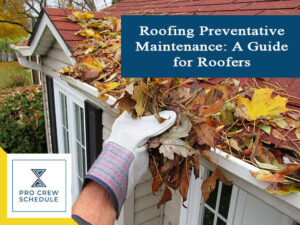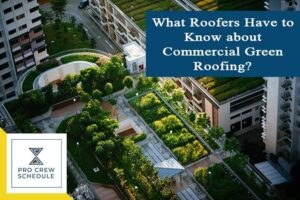All roofing experts generally agree that a roofing system requires quality materials, pleasing designs, and quality inspections to be excellent and to ultimately perform well. Following the installations of a new roofing system, it is also essential to consider and establish a preventative maintenance program and use advanced software tools like a construction project management software. The primary purpose of establishing preventative maintenance is to attain the roofing system’s anticipated service life and its components. The software tool, on the other hand, is used for project management purposes.
Only a trained and qualified roofing contractor can execute extensive inspections and appropriately assess the current condition of all roofing components. Additionally, only these roofing experts are capable of identifying defects and perform all essential repairs. Using the best construction management software like Pro Crew Schedule, doing all these works is made easier. Software tools like this are designed to cater to the needs of all construction professionals, including roofers.
In today’s article, the importance of preventative maintenance is going to be outlined, including more other essential details.
The Need for Roofing Preventative Maintenance
Roofers agree that regular roofing maintenance proactively addresses the conditions that can adversely affect its performance. These professionals prefer to use builder trends software whenever repairs, maintenance and other services will be executed and they find the software tool very useful. All found issues in the roofing system and the building components are typically there because of moisture and water infiltration. Humidity and water within the roofing system can result in corrosion, deterioration, decking, and many others. Interior finishes, electrical systems, fixtures can also be a subject of damage because of infiltrations. Needless to say, but this particular type of damage can ultimately cost thousands of dollars to rectify.
Roofs are consistently subject to deteriorating and stress effects due to direct exposure to environmental conditions. That is why a timely and thorough preventative maintenance is crucial because it can address many situations that usually require remedial repairs. At the same time, it maximizes the long-term performance of the system. Before anything else, roofers have also prioritized the use of a builder schedule software. The tool is best used for scheduling purposes and has proven to produce so much work productivity. Furthermore, roofers need to have further knowledge about the many factors that severely affect the long-term performance of roofs.
Below are some of the most common factors that directly affect the roof’s performance that causes aging of roof components and deterioration.
· Structural movements such as seismic movement, contraction, settlements, and contraction
· Lack of regular and proper maintenance including the utilization of incompatible of materials
· Exposure to environmental elements such as rain, temperature, snow, industrial emissions, ultraviolet radiation
· Biological growth such as algae, vegetation and fungus
· Inadequate designs of the roofing system including improper flashings, drainage and structural deficiencies
· Changes to the occupancy and use of the buildings
· Manufacturing defects like errors in fabrication and formulation
If defects are being left unattended, it could lead to infiltrations of either water or moisture. An experienced roofing contractor has the experience, knowledge and the skills to resolve the found defects. And to suitably match their knowledge and expertise, roofers have the option to use advanced technologies. One of the amazingly designed software tools today is the construction scheduling software that has been used by many construction professionals. Tracking, monitoring, managing projects and scheduling tasks and crew are all easier to use. The efficiency of project management for construction also tend to increase using the tool.
Several Common Areas to Document and Inspect
A program for preventative maintenance consists of 2 main parts – the inspection and the execution. During an inspection, several complex structures require special access and special assistance from the contractors. During the assessment, it is crucial to document all the findings and keep these all in a proper and consistent format each year. Inputting, maintaining and storing all collected data is easier to do now that a crew schedule software is deployed. Accessing all information is possible anytime and anywhere. It is also vital to inspect further any works that have been performed recently since the repairs can still be under warranty.
Experienced roofing professionals inspect the following specific items:
1. Roofs, Drains, Drainage, down sprout
Many things contribute to the clogged gutters and ponding of the water and it includes the decayed leaves, dirt runoff, pine needles and a lot more. All roof drains must remain clear from any obstructions. Thawing and freezing of ponding water during fall and winter can ultimately cause severe roof damage.
2. Expansion Joints and Building control
These particular elements of a structure have its expansion joints and controls easily damaged. Roofers are very detailed in this issue since it was not all the time acknowledged. Furthermore, evidence for the damage found has included cracking, warping, leaking of water, screws are loosened, and many more.
3. Perimeters of windows, doors and other wall penetrators
One of the significant sources of water leakage is the exterior walls. Noticeably, numerous openings are necessarily required in residential and commercial building walls, including irrigation connections, plumbing, HVAC system elements, air intakes, exhaust vents, fire alarms and many other more. However, unplanned holes might be present and it is caused by the aging brick joints that require re-pointing.
4. Driving/Walking surfaces
Just when water infiltrates the concrete, it can cause freezing that leads water almost to occupy 9% more volume than its liquid state. This particular expansion has caused distress on the concrete that often leads to severe fractures that usually continue to grow expansively as the used materials’ saturation increases. The signs of damage for this area include spalls, cracks, potholes and heaves.
5. Flashings and Copings
When roofers are surveying the roofs, they have to inspect both the flashings and the copings further. The water damage situated in the interior and exterior walls can be a massive issue of the associated elements aren’t properly maintained. It is crucial for the roofers to always keep this in mind and prioritized this matter once and for all.
Preventative maintenance is where regularly scheduled inspections are included and periodic repairs of all roofing components like drains, flashings, curbs, etc.). For inspections, one of the most preferred recommendations by the roofers is to have the roofs inspected for at least twice in a year – once every fall and once in spring. Below is what every roofing professional do during inspections:
· Inspect rooftop vents and the associated equipment to ensure that these are very well sealed.
· Inspect downspouts and drains to ensure that it is clear from any blockage
· Check flashings and penetrations for any tears or gaps
· Look for any occurring signs of damage from the roofs and then recommend solutions afterward
Benefits of Preventative Roof Maintenance
1. Water pooling is prevented
There are different roofing system types, and the flat types are most usually at risk when it comes to water pooling. It is because flat roofs typically lack of pitch. If this isn’t acknowledged right away, it can lead to uninterrupted water damage towards the roof, resulting in more developing issues.
2. Protects investment
Small leaks are, at times, not considered as a significant issue that requires immediate attention. However, regardless of small or large, leaks are capable of doing real damage to any properties. Deterioration in the property is usually what clients and property owners often frustrated about. Roofers are always on the rescue as they are still readily-equipped with all of the necessary tools, etc. They also implement a construction crew management to supervise all crew members involved in the projects.
3. Expensive Repairs aren’t any more necessary
Repairing the roofs is undoubtedly expensive, mainly when the damages found are severe. For instance, a leak can start as small, yet it enlarges itself and quickly becomes worse after a few days or weeks. It costs a lot lesser to maintain the roofs compare in repairing the wide-spreading damage proactively.
4. Extends the Roof’s Lifespan
It is already proven that preventative roof maintenance can able to prolong the lifespan of the roof. Both residential and commercial roofing systems usually have longer lifespans; however, this factor doesn’t change the fact that damage still occurs. General wear and tear issues, including elemental damage, will always show up now and then, mostly when maintenance isn’t done.
Key Takeaways
Appropriate preventative maintenance is undoubtedly one of the most effective tools for prolonging the life service of a roofing system, both residential and commercial. It also allows for a very organized approach to effective roof asset management. Roofers have to keep in mind all the essential factors that are associated with it.





